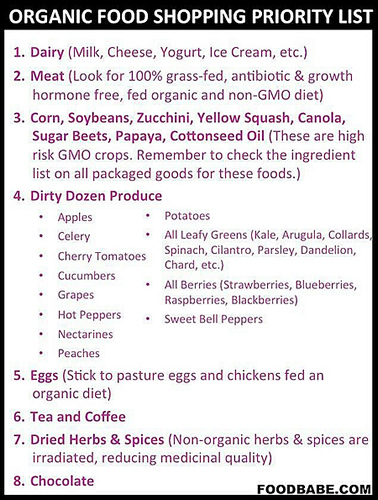| BlueSky Business Aviation News | ||||||||||||||||||||||||||||||||||||||||||||||||||||||||||||||||||||||||||||
| . | ||||||||||||||||||||||||||||||||||||||||||||||||||||||||||||||||||||||||||||
Today however, as I perused the stack of orders to be invoiced, I happened to notice that each client was requesting some form of organic food to be included in their catering order. I was amazed. I was the person slow to convert our kitchen to organic produce, fighting the trend all the way; but I converted and now feel that it’s given me a bit more control over my life and my health.
What does ‘organic’ mean, literally? The term ‘organic’ refers to the way agricultural products are grown and processed. Specific requirements must be met and maintained in order for products to be labeled as organic. Organic crops must be grown in safe soil, have no modifications, and must remain separate from conventional products. Farmers are not allowed to use synthetic pesticides, bioengineered genes (GMOs), petroleum-based fertilizers, or sewage sludge-based fertilizers. Organic livestock must have access to the outdoors and be given organic feed, which frequently can only occur on smaller local farms. Animals may not be given antibiotics, growth hormones, or any animal-by-products. It seems a more ‘humane’ way of life. These animals tend to be healthier and their products - milk, eggs, meat - according to some, have more vitamins, minerals, antioxidants and nutritive value than their counterparts from animals found in commercial feed lots. In addition, people with allergies to foods, chemicals, or preservatives often find their symptoms lessen or go away when they eat only organic foods. You hear it over and over. Organic foods hold the upper hand over processed foods in terms of their overall health benefits. The common sentiment seems to be the more natural a food is, the better it is for you. This is the basis of clean eating, and mindful eating life styles. Non organic and/or processed foods can get contaminated with chemicals and other problematic ingredients, but with organic products it's easier to know exactly what you're putting into your body. I stumbled on this list of reasons many people, including our flight crew and passengers, request organic: Organic produce contains fewer pesticides. Pesticides are chemicals such as fungicides, herbicides, and insecticides. These chemicals are widely used in conventional agriculture and residues remain on (and in) the food we eat. Organic food is often fresher. Fresh food tastes better. Organic food is usually fresher because it doesn’t contain preservatives; It is not waxed or treated to preserve it to last longer. Organic produce is often produced on smaller farms near where it is sold. Organic farming is better for the environment. Organic farming practices reduce pollution (air, water, soil), conserve water, reduce soil erosion, increase soil fertility, and use less energy. Farming without pesticides is also better for nearby birds and small animals as well as people who live close to or work on farms. Here’s a bit of trivia for you: the average distance a meal travels from the farm to the dinner plate is 1,500 miles. This uses a lot of fossil fuels and produces carbon dioxide. Organically raised animals are NOT given antibiotics, growth hormones, or fed animal byproducts. The use of antibiotics in conventional meat production helps create antibiotic-resistant strains of bacteria. This means that when someone gets sick from these strains they will be less responsive to antibiotic treatment. Not feeding animal byproducts to other animals reduces the risk of mad cow disease (BSE). In addition, the animals are given more space to move around and access to the outdoors, both of which help to keep the animals healthy. Organic food is GMO-free. Genetically Modified Organisms (GMOs) or genetically engineered (GE) foods are plants or animals whose DNA has been altered in ways that cannot occur in nature or in traditional crossbreeding, most commonly in order to be resistant to pesticides or produce an insecticide. In most countries, organic crops contain no GMOs and organic meat comes from animals raised on organic, GMO-free feed. GMOs are common in crops such as corn, soybeans, alfalfa, squash, zucchini, papaya, and canola, and are present in many breakfast cereals and most of the processed food that we eat. Take a look at your favorite canned or packaged food. If the ingredients include corn syrup or soy lecithin, chances are it contains GMOs. Since GMO’s are relatively new, no long term studies have been completed to see if there is a definite effect on humans. But . . . GMOs have been linked to increased food allergens and gastro-intestinal problems in humans. To date research linking GMOs and serious disease has not been proven. Organic vs. Non Organic Produce
For these 14 fruits and vegetables . . . simply put . . . an organic label does matter! Those pictured above and listed below have the highest pesticide levels on average of all produce. Because of their high pesticide levels when conventionally grown, insist your catering source buys these items organic:
The following conventionally grown fruits and vegetables were found to have the lowest levels of pesticides and do not require that ‘must have’ organic label. Most of these have thicker or layered skin, which naturally protects them better from pests.. which means their production does not require the use of as many pesticides.
I have you thinking, right? If this happens with produce, what about our meat and dairy? After all, these animals eat the produce too. There are many differences between the outcomes of conventional vs. organic other than the food they are fed. Organic vs. Non Organic Meat, Dairy and Eggs Although regulations governing meat and dairy farming vary from country to country, the basis is similar.
Meat, poultry and dairy animal products (such as eggs, cheese, butter, yogurt, milk, etc.) are the most important to buy organic because of the combined risk of pesticide, animal diet, anti-biotic potential and cancer causing growth hormone exposure. There are numerous new laws now being enforced in the US (Jan 1, 2015) concerning the cold food chain from the grower to the end consumer that is a topic all of its own. Every single catering source, whether restaurant, caterer, personal chef or cook at the flight department now fall under these Federal Food and Drug Guidelines (for labeling, cold chain control, working HACCP plans and bio terrorism) and any caterer or food source outside the United States providing food which crosses its borders also falls under guidelines. Many countries have aligned themselves, so multi-country inspection will occur. Hold on . . . more to come on this soon. In the meantime, labeling of meat, dairy, and egg products may become a bit more complicated. I have listed a few examples of an accepted term and what it implies and now officials will check and inspect these for compliance as well. Natural or all natural - “This label means “minimally processed” and that the meat can’t have any artificial colors, artificial flavors, preservatives, or any other artificial ingredients in it. Animals can still be given antibiotics or growth enhancers and meat can be injected with salt, water, and other ingredients. For example, this term can be applied to all raw cuts of beef since they aren’t processed. The natural label does not reflect how the animal was raised or fed, which makes it fairly meaningless. Naturally raised - This claim should be followed by a specific statement, such as “naturally raised without antibiotics or growth hormones” in order to obtain USDA approval. Read different labels carefully to understand what naturally raised really means to the piece of meat you’re buying. Grass-fed - This term claims that the animals are fed solely on a diet of grass or hay and have continuous access to the outdoors. Cattle are naturally ruminants that eat grass, so they tend to be healthier and leaner when fed this way. In addition, grass fed beef has been shown to have more of the healthy omega-3 fatty acids. However, if meat is labeled as grass fed but not certified organic, the animal may have been raised on pasture that was exposed to or treated with synthetic pesticides or fertilizers. Free-range or free-roaming - Broadly, this term means that the animals weren’t confined to a cage and had access to the outdoors. Unfortunately, there are no requirements for the amount of time the animals spend outdoors or for the size of the outdoor space available. The terms free-range or free-roaming also don’t apply to egg-laying hens. It’s difficult to tell exactly what free range means on meat packaging, so again beware. Cage-free - The term means that egg-laying hens are not raised in cages. However, it does not necessarily mean they have access to the outdoors. Trivia tidbit for you…Studies have shown caged eggs are up to 21 percent more likely to harbor salmonella than those not caged. Pasture-raised - This claims that the animals were not raised in confinement and had year-round access to the outside. Again, there are no requirements for exactly how much time the animals spend outside or the size of the outdoor space available, so it can be misleading. Another trivia tidbit I find very interesting having been served cage free eggs from chickens roaming the garden and fields of a friend’s home. I actually was invited to go in search of breakfast eggs. The gold standard for egg selection - Local pastured eggs supplemented with organic grain. A study published last year in the journal Renewable Agriculture and Food Systems discovered that hens raised on fresh pastures boasted twice as much vitamin E and 2.5 times more total omega-3 fatty acids than eggs from caged birds. Independent tests cite that eggs from pastured hens contain 4 to 6 times the vitamin D of a standard supermarket egg. Here are some other findings for pastured eggs:
No hormones added or hormone-free – This term indicates that animals are raised without the use of any added growth hormones. For beef and dairy products it can be helpful, but by law if in the U.S., poultry, veal calves, and pigs cannot be given hormones anyway. This label is very misleading. Certified Humane Raised and Handled – This is a voluntary certification regulated by the Humane Farm Animal Care, a non-profit organization aimed at ensuring the humane treatment of farm animals. The label means that animals have ample space, shelter, and gentle handling to limit stress, ample fresh water, and a diet without added antibiotics or hormones. Animals must be able to roam around and root without ever being confined to cages, crates, or tie stalls. Is Organic more nutritious? Healthy? The answer is not that simple. Modern eating habits have a more profound effect on a person’s health than a decision to buy organic or not. Most of us are not eating the right kind of food. Too much meat and fatty dairy, too little plants. Too many processed snacks, too little real foods. Refined sugars and flours instead of whole grains, but this is a change in progress which is evidenced by the change in catering requests. Not just to me, but to caterers around the world. You are seeing more local products mentioned on their new menus, more descriptive terms relating to food origin, and social responsibility finding a home in the millennial generation. Don’t get me wrong, the organic movement is super important and is moving faster each year. I read that 70% of Americans are buying organic and that one fourth of them are doing it on a weekly basis. Organic matters for sustainability, animal welfare, reduction of pesticide and hormone use which are important on a regional, national, and global level. If you are not eating organic, I would suggest you begin to transition by changing to the organic foods on the highest pesticide residue list. In summary, if you join the organic movement and purchase organic catering for your passengers and flight crew, I have attached a chart I found of the foods which you should insist that the catering source locate organic for you - especially if organic is currently not a staple in their kitchen.
Let me introduce myself . . . My name is Paula Kraft and I am founder and President of Tastefully Yours Catering, an aviation specific caterer, located in Atlanta, Georgia for over 35 years.
Currently I am an active member of the NBAA Flight Attendant Committee Advisory Board and the NBAA International Flight Attendant Committee, Women in Corporate Aviation, Women in Aviation International, National Association of Catering Executives, International Flight Catering Association, the International Food Service Association and the International Caterer’s Association. I have coordinated training programs and clinics for NBAA, EBAA and BA-Meetup conference attendees for over 10 years, created mentoring programs for caterers and flight attendants to broaden their aviation culinary skills, and to assist them in adapting to the unique challenges and constraints found in catering for general aviation. I recognize the need for training and have worked closely with flight departments, flight crews, schedulers and customer service reps at the FBOs to ensure that catering specific training provides information and skills necessary to reduce risk while assisting them in their job duties that include safe food handling, catering security, accurate transmission of food orders, and safe food production, packaging and delivery. I fell into aviation catering quite by accident. I was the in-house caterer and bakery supplier for Macy’s department stores in Atlanta when catering was ordered for a Macy’s customer which was soon to change my life. After the client enjoyed the catering provided, I was summoned to the client’s corporate office to provide several of the items delivered through Macy’s to the executive dining room. Within a week, I was providing food for the flight department and my first order was for the President of a foreign country (as I was too be told soon after). So, here I am, some 35 years later, still loving every minute of every day in aviation catering.
|
||||||||||||||||||||||||||||||||||||||||||||||||||||||||||||||||||||||||||||






